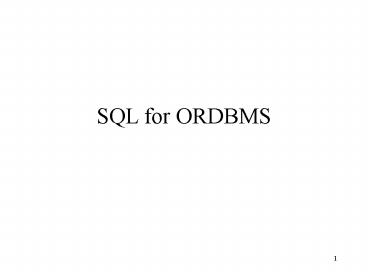SQL for ORDBMS PowerPoint PPT Presentation
1 / 17
Title: SQL for ORDBMS
1
SQL for ORDBMS
2
Contents
- SQL standards
- SQL procedures
- SQL types
- Distinct types, UDTs, LOBs, collections, REFs
- Triggers
- Encompassing transaction support
- SQL/MM
3
SQL standards
- SQL has been used in relational databases for 20
years, and was defined as a standard in 1986. - Not all implementations follow the standard
- Enhancements led to SQL2 which became SQL-92.
- SQL3 was planned to include extensions for OO.
- It was delayed, and eventually became SQL1999
- There will be more versions!
4
SQL procedures
- SQL-92 was not computationally complete
- Procedures and functions in SQL are now supported
- SQL/PSM (Persistent Stored Modules) was developed
in 1996 - Other languages such as Java are also supported
- SQL1999 incorporated this feature
5
SQL types (1)
- Simple types for numbers, text have been in the
standard all the time - SQL1999 includes LOBs (large objects) with both
CLOB and BLOB variants - It also has LOB locators to access LOBs without
necessarily moving the LOB from a server to a
client
6
SQL types (2)
- Distinct types (DT) allow you to use a new name
for a type, associated with an existing type - CREATE DISTINCT TYPE payNo AS INTEGER
- Restricts use of payNo values they cant be
combined with other integers
7
SQL types (3)
- Row types
- CREATE ROW TYPE fullname
- (forename VARCHAR(20),
- surname VARCHAR(20) )
- Row types can be used to define cells in a table,
or whole rows.
8
SQL types (4)
- Collections
- Sets, bags (multisets), lists, ARRAY
- Operations, such as
- Union, Intersect, Difference (sets, bags)
- Counting number of elements
- Concatenating lists
- etc.
9
SQL types (5)
- Structured User-defined types
- Attributes defined for them
- Methods, functions and procedures defined
- Attributes accessible only via system-generated
set and get functions (observer and mutator) - Type hierarchies allowed inheritance
- Similar to Javas single-inheritance
10
SQL types (6)
- REF types
- These hold references to other data objects
- In effect, they hold object-identifiers to
reference the object itself
11
Triggers
- Triggers are procedures that are run when a
trigger event occurs - A trigger event is associated with an UPDATE,
INSERT or DELETE operation on a base table, and
is either BEFORE the operation or AFTER it. - For example, a trigger might log all before and
after values of a row when it is updated.
12
Triggers and integrity
- The built-in integrity constraints supported by a
DBMS can be complemented by user-defined triggers - A trigger can check the consistency of the data
before an operation occurs
13
SQL for Multimedia
- User-defined types and LOBs provide a way of
incorporating MM data into a database - The data representation is held in a LOB
- Associated fields can be used to add features
- The methods and functions can provide specialised
operations for the multimedia data - The database designer could define all this
- Or, these could be provided as a library feature
14
SQL/MM
- A group of developers looked at providing
Multimedia support in SQL, called SQL/MM. - The developments were done in parallel with the
development of the SQL1999 standard - They used ideas similar to the UDTs.
15
Some limitations of SQL1999
- With simple data types, the index mechanisms were
well-defined and efficient implementations were
possible - How do you provide efficient implementations with
complex data? - Video sound have streams of data should you
manage the timing of these?
16
Limitations (2)
- In a distributed system, where a client is
handling large MM objects on a server, - How do you decide whether to transfer the object
to the client or perform the operation at the
server? - How do you manage the distribution of the
functions?
17
Summary
- SQL has developed from relational databases to
Object-relational - Standard SQL1999 incorporates object features
that can support MM - SQL/MM was a parallel development
- There are still limitations in the language and
its implementations

